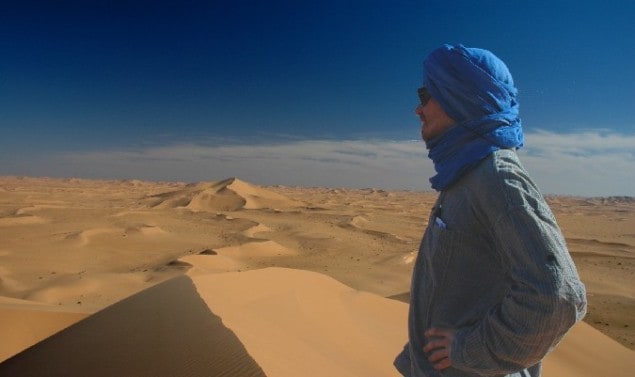
Giant sand dunes can gather into some of the most awe-inspiring patterns in nature. However, the mechanics of their formation has long remained a mystery. Now a group of physicists based in Algeria, the US and France suggests that the topology of these desert landscapes is governed by the thickness of the atmospheric layer above; a process similar to dunes forming on a river bed. The finding could act as a starting point for modelling the long-term evolution of desert environments, say the researchers.
After an expedition to the Algerian erg (a “sand sea”), the researchers combined field measurements with aerodynamic calculations to model the interaction between the desert floor and the atmosphere. They discovered that there exists a correlation between the separation of dunes and the height of the overlying atmospheric boundary layer — the part of the atmosphere that interacts directly with the Earth’s surface (Nature 457 1120).
“This study is fundamental: in principle our findings apply to all sandy deserts where the amount of sand available for transport by the wind is sufficiently large,” said Philippe Claudin, one of the researchers at the Laboratoire de Physique et Mecanique in Paris.
Learning from the river
The calming sight of evenly spaced dunes along a river bed is in fact the result of rough bed topography. Inconsistencies in the river bed cause turbulence in the water — leading surface waves — which in turn stabilize the water flow along the river bed. The result is a controlled repetition of “waves” in the river silt where the wavelength is directly proportional to the depth of the river.
According to Claudin and his colleagues, calculations reveal a similar process takes place in desert environments. Here, instead of a river surface, it is the ABL that acts as a stabilizer for “waves” in the desert — the thicker the ABL the larger the distance between neighbouring giant dunes.
Comparing dune separation from deserts around the world with the overlying ABL thickness, the researchers explained the range of mean spacing of 300 m in coastal terrestrial desserts to 3.5 km inland. Also, contrary to previous theories, the researchers report that giant dunes do not grow in a steady manner but result from the non-linear interaction of small dunes.
A complete picture?
“This study does a lot to convince that the overall stabilizing influence of the free atmosphere plays indeed a central role for limiting the size of giant dunes,” said Eric Partelli, a sand dune researcher at the University of Stuttgart.
Other researchers were less certain of the completeness of this theory. “The proposed mechanism is very appealing, but I think they could now calculate the time evolution and compare the final shape of the dunes with real world measurements,” said Hans Herrmann a researcher of Granular Matter at the University of Zurich.
Claudin told physicsworld.com that his team now plans to investigate specific dune fields in more detail. “We will start to look at dunes of all scales in order to go beyond the scale issue.”



